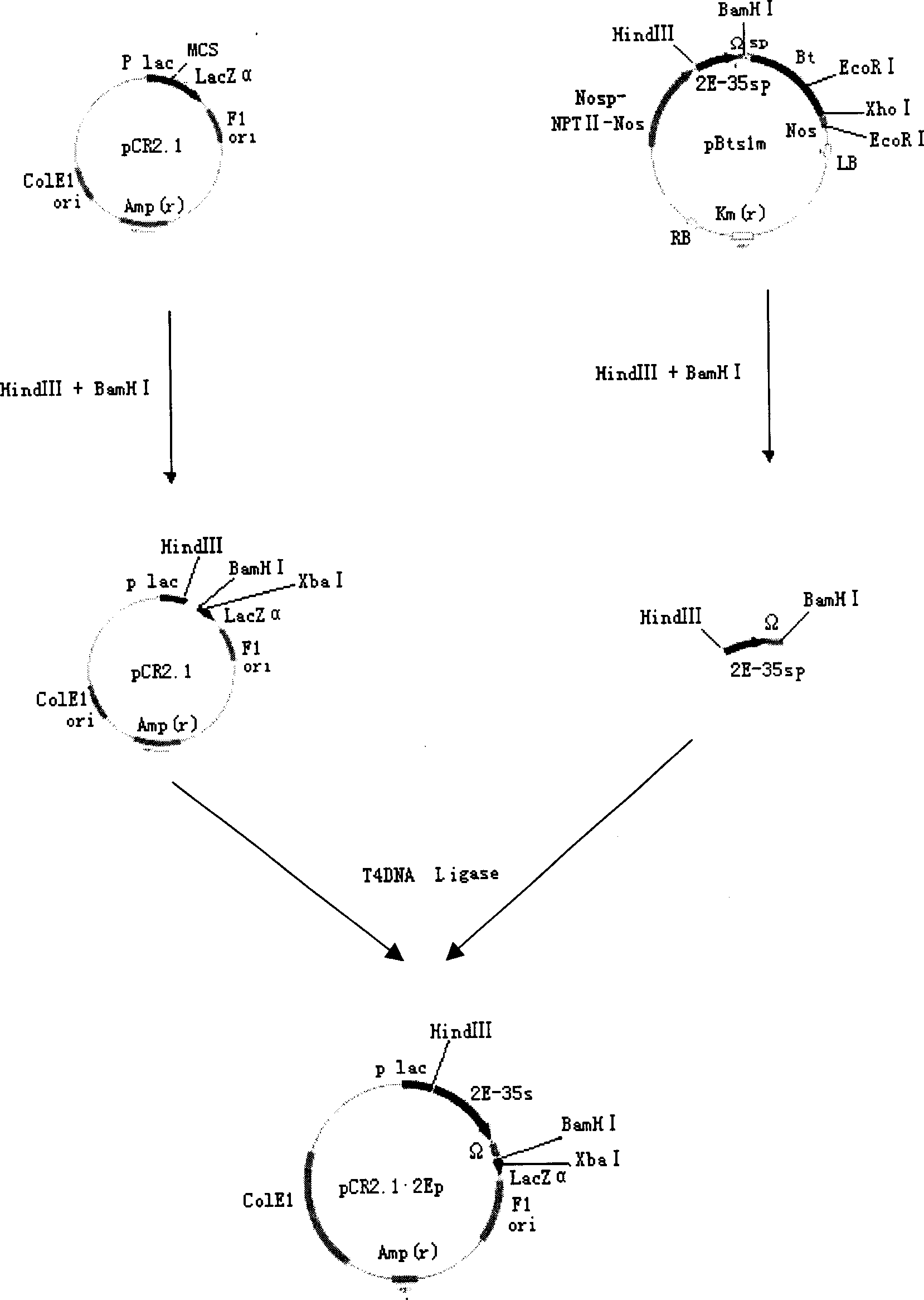Plant polygene expression carrier, transforming factor containing said carrier and its application
An expression vector and multi-gene technology, applied in the field of plant genetic engineering, can solve problems such as the influence of transgenic plant traits, physiological function interference, etc., and achieve the effects of good glyphosate resistance and good insect resistance.
- Summary
- Abstract
- Description
- Claims
- Application Information
AI Technical Summary
Problems solved by technology
Method used
Image
Examples
Embodiment 1
[0022] The construction of embodiment 1 plant polyvalent expression vector
[0023] According to the double enzyme digestion reaction and electrophoresis system shown in Table 1.1, the plasmid pBtS1m (plasmid containing the BtS1m gene, Chinese patent application CN1393561A) and pCR2.1 plasmid containing the 2E-35S+Ω fragment were cut with HindIII+BamHI, and agarose gel After gel electrophoresis, use E.Z.N.A Gel Extraction kit (Omega, the same below) recovered the two bands at about 0.8kb and 3.9kb respectively to obtain the 2E-35S+Ω fragment and the pCR2.1 plasmid with a gap, and then used T4DNA ligase to convert the recovered 0.8kb Ligated with the two-part DNA fragment of 3.9kb (see Table 1.2 for the ligation reaction system), the pCR2.1.2Ep plasmid containing the 2E-35S+Ω fragment was obtained (see figure 1 ); cut the pCR2.1 aroAM12 and pCR2.1.2Ep plasmids containing the aroAM12 gene fragment with BamHI+XbaI respectively, obtain the pCR2.1.2Ep plasmid containing the aroA...
Embodiment 2
[0038] The acquisition of embodiment 2 escherichia coli transformants
[0039] Preparation of E.coli XL-1-blue competent cells: ①Put a single colony of XL1-blue into 5mL LB liquid medium (see Table 2.1) without antibiotics, shake overnight at 37°C; ②Press 1% The amount of (v / v) was transferred to fresh LB liquid medium and shaken to OD at 37°C 600 =0.3; ③Add 50-100mL LB liquid culture medium (see Table 2.1 for LB preparation) into two sterile centrifuge tubes, place on ice for 30 minutes; ④Centrifuge at 4°C, 4000rpm (rev / min) for 10 minutes , remove the supernatant, and add 10 mL of pre-cooled 0.1% CaCl to each centrifuge tube 2 Resuspend the cells in the solution, and put them in an ice bath for 30 minutes. ⑤ Centrifuge at 4°C and 4000rpm for 10 minutes, remove the supernatant, and suspend the cells in 2 mL of pre-cooled 0.1% CaCl 2 Add 300 μL of sterile glycerol to the solution, mix well, add 100 μL of XL1-blue competent cells to each sterile centrifuge tube, and store at ...
Embodiment 3
[0048] The transformation of embodiment 3 Agrobacterium tumefaciens
[0049] Preparation of Agrobacterium tumefaciens LBA4404 competent cells: ① Pick LBA4404 colonies from the YEB solid medium (see Table 3.1) plate containing streptomycin (str) and rifampicin (Rif), inoculate into 5ml containing the corresponding antibiotic In the YEB liquid medium (according to Table 3.1, without adding agar), shake overnight at 200 rpm at 28°C. ② Dilute to 50ml with YEB liquid medium, then culture at 28°C and 200rpm for 6-12 hours until OD 600 The value is around 0.6. ③ Place on ice for 5 minutes, then centrifuge at 4°C, 2000rpm for 7 minutes. ④Take 1ml of ice-cold CaCl with a concentration of 20mmol / L 2 Resuspend the precipitate in the solution and mix well. ⑤ Divide into 10 portions, 100 μl each, and store in a -70°C refrigerator for later use.
[0050] Add 5 μl of the plasmid extracted in Example 2 to 100 μl of Bacillus LBA4404 competent cells stored in a -70°C refrigerator, bathe in...
PUM
 Login to View More
Login to View More Abstract
Description
Claims
Application Information
 Login to View More
Login to View More - R&D
- Intellectual Property
- Life Sciences
- Materials
- Tech Scout
- Unparalleled Data Quality
- Higher Quality Content
- 60% Fewer Hallucinations
Browse by: Latest US Patents, China's latest patents, Technical Efficacy Thesaurus, Application Domain, Technology Topic, Popular Technical Reports.
© 2025 PatSnap. All rights reserved.Legal|Privacy policy|Modern Slavery Act Transparency Statement|Sitemap|About US| Contact US: help@patsnap.com



